Assessment | Annotated Bibliography - Conservation Areas
VerifiedAdded on 2022/08/30
|6
|1948
|22
AI Summary
Contribute Materials
Your contribution can guide someone’s learning journey. Share your
documents today.
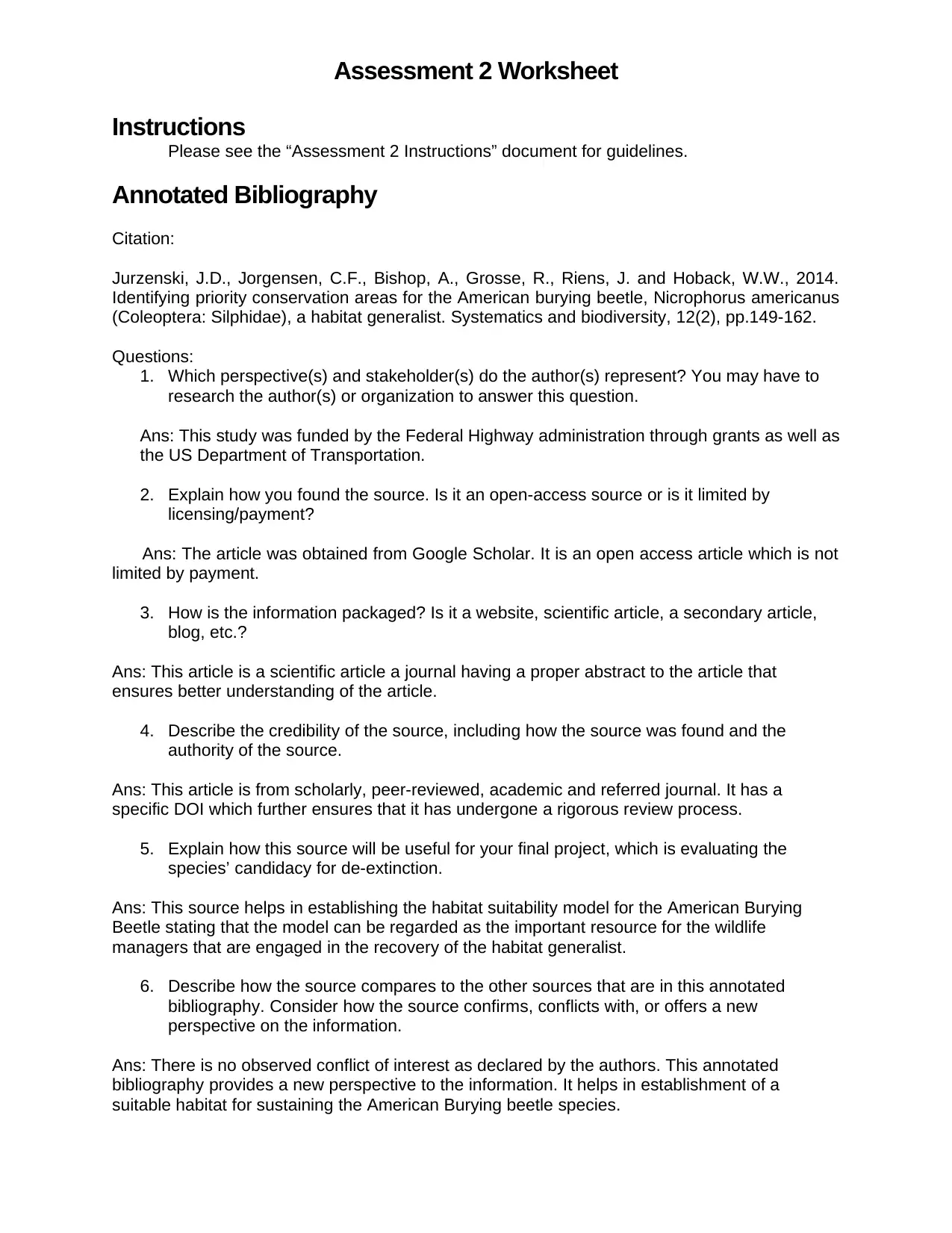
Assessment 2 Worksheet
Instructions
Please see the “Assessment 2 Instructions” document for guidelines.
Annotated Bibliography
Citation:
Jurzenski, J.D., Jorgensen, C.F., Bishop, A., Grosse, R., Riens, J. and Hoback, W.W., 2014.
Identifying priority conservation areas for the American burying beetle, Nicrophorus americanus
(Coleoptera: Silphidae), a habitat generalist. Systematics and biodiversity, 12(2), pp.149-162.
Questions:
1. Which perspective(s) and stakeholder(s) do the author(s) represent? You may have to
research the author(s) or organization to answer this question.
Ans: This study was funded by the Federal Highway administration through grants as well as
the US Department of Transportation.
2. Explain how you found the source. Is it an open-access source or is it limited by
licensing/payment?
Ans: The article was obtained from Google Scholar. It is an open access article which is not
limited by payment.
3. How is the information packaged? Is it a website, scientific article, a secondary article,
blog, etc.?
Ans: This article is a scientific article a journal having a proper abstract to the article that
ensures better understanding of the article.
4. Describe the credibility of the source, including how the source was found and the
authority of the source.
Ans: This article is from scholarly, peer-reviewed, academic and referred journal. It has a
specific DOI which further ensures that it has undergone a rigorous review process.
5. Explain how this source will be useful for your final project, which is evaluating the
species’ candidacy for de-extinction.
Ans: This source helps in establishing the habitat suitability model for the American Burying
Beetle stating that the model can be regarded as the important resource for the wildlife
managers that are engaged in the recovery of the habitat generalist.
6. Describe how the source compares to the other sources that are in this annotated
bibliography. Consider how the source confirms, conflicts with, or offers a new
perspective on the information.
Ans: There is no observed conflict of interest as declared by the authors. This annotated
bibliography provides a new perspective to the information. It helps in establishment of a
suitable habitat for sustaining the American Burying beetle species.
Instructions
Please see the “Assessment 2 Instructions” document for guidelines.
Annotated Bibliography
Citation:
Jurzenski, J.D., Jorgensen, C.F., Bishop, A., Grosse, R., Riens, J. and Hoback, W.W., 2014.
Identifying priority conservation areas for the American burying beetle, Nicrophorus americanus
(Coleoptera: Silphidae), a habitat generalist. Systematics and biodiversity, 12(2), pp.149-162.
Questions:
1. Which perspective(s) and stakeholder(s) do the author(s) represent? You may have to
research the author(s) or organization to answer this question.
Ans: This study was funded by the Federal Highway administration through grants as well as
the US Department of Transportation.
2. Explain how you found the source. Is it an open-access source or is it limited by
licensing/payment?
Ans: The article was obtained from Google Scholar. It is an open access article which is not
limited by payment.
3. How is the information packaged? Is it a website, scientific article, a secondary article,
blog, etc.?
Ans: This article is a scientific article a journal having a proper abstract to the article that
ensures better understanding of the article.
4. Describe the credibility of the source, including how the source was found and the
authority of the source.
Ans: This article is from scholarly, peer-reviewed, academic and referred journal. It has a
specific DOI which further ensures that it has undergone a rigorous review process.
5. Explain how this source will be useful for your final project, which is evaluating the
species’ candidacy for de-extinction.
Ans: This source helps in establishing the habitat suitability model for the American Burying
Beetle stating that the model can be regarded as the important resource for the wildlife
managers that are engaged in the recovery of the habitat generalist.
6. Describe how the source compares to the other sources that are in this annotated
bibliography. Consider how the source confirms, conflicts with, or offers a new
perspective on the information.
Ans: There is no observed conflict of interest as declared by the authors. This annotated
bibliography provides a new perspective to the information. It helps in establishment of a
suitable habitat for sustaining the American Burying beetle species.
Secure Best Marks with AI Grader
Need help grading? Try our AI Grader for instant feedback on your assignments.
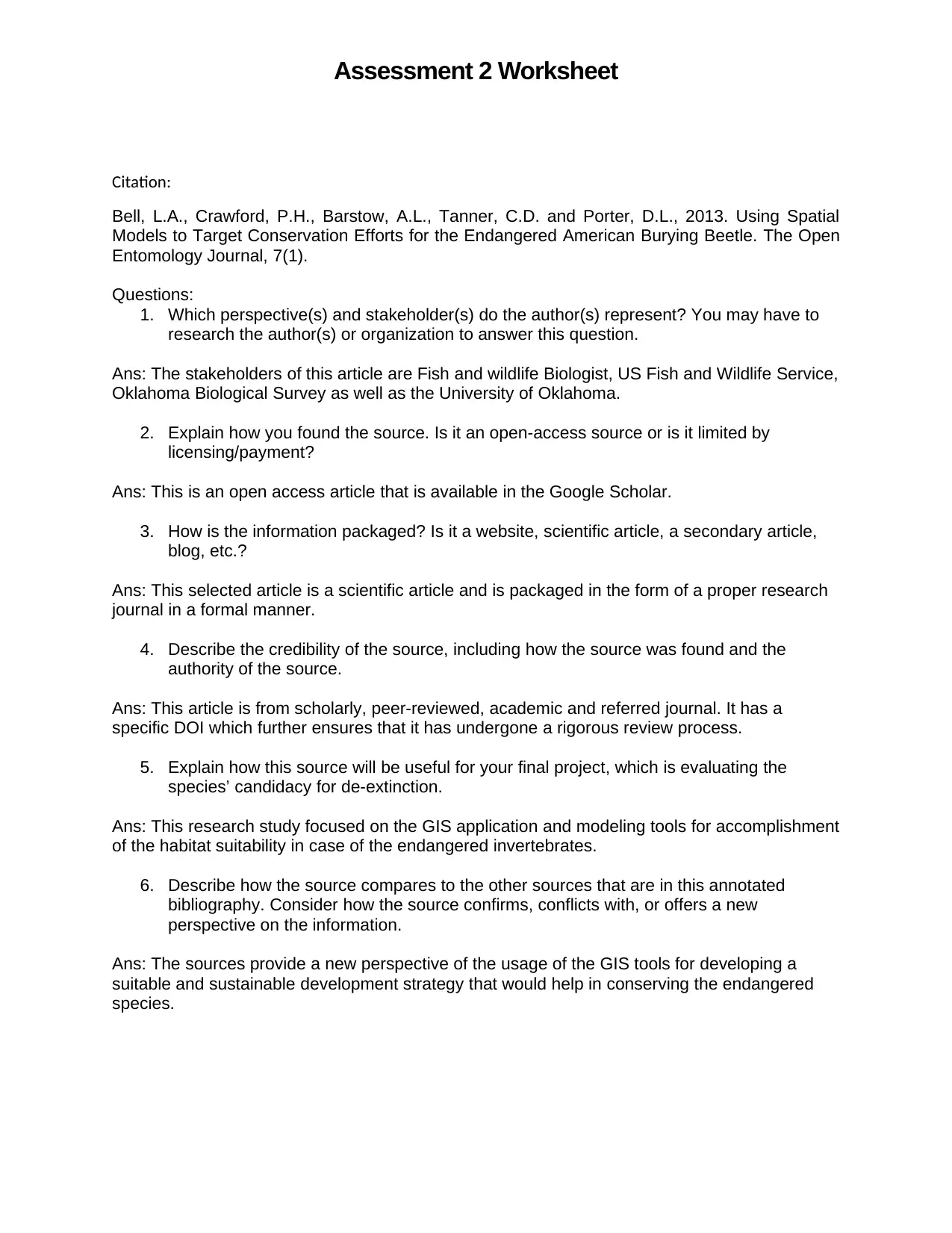
Assessment 2 Worksheet
Citation:
Bell, L.A., Crawford, P.H., Barstow, A.L., Tanner, C.D. and Porter, D.L., 2013. Using Spatial
Models to Target Conservation Efforts for the Endangered American Burying Beetle. The Open
Entomology Journal, 7(1).
Questions:
1. Which perspective(s) and stakeholder(s) do the author(s) represent? You may have to
research the author(s) or organization to answer this question.
Ans: The stakeholders of this article are Fish and wildlife Biologist, US Fish and Wildlife Service,
Oklahoma Biological Survey as well as the University of Oklahoma.
2. Explain how you found the source. Is it an open-access source or is it limited by
licensing/payment?
Ans: This is an open access article that is available in the Google Scholar.
3. How is the information packaged? Is it a website, scientific article, a secondary article,
blog, etc.?
Ans: This selected article is a scientific article and is packaged in the form of a proper research
journal in a formal manner.
4. Describe the credibility of the source, including how the source was found and the
authority of the source.
Ans: This article is from scholarly, peer-reviewed, academic and referred journal. It has a
specific DOI which further ensures that it has undergone a rigorous review process.
5. Explain how this source will be useful for your final project, which is evaluating the
species’ candidacy for de-extinction.
Ans: This research study focused on the GIS application and modeling tools for accomplishment
of the habitat suitability in case of the endangered invertebrates.
6. Describe how the source compares to the other sources that are in this annotated
bibliography. Consider how the source confirms, conflicts with, or offers a new
perspective on the information.
Ans: The sources provide a new perspective of the usage of the GIS tools for developing a
suitable and sustainable development strategy that would help in conserving the endangered
species.
Citation:
Bell, L.A., Crawford, P.H., Barstow, A.L., Tanner, C.D. and Porter, D.L., 2013. Using Spatial
Models to Target Conservation Efforts for the Endangered American Burying Beetle. The Open
Entomology Journal, 7(1).
Questions:
1. Which perspective(s) and stakeholder(s) do the author(s) represent? You may have to
research the author(s) or organization to answer this question.
Ans: The stakeholders of this article are Fish and wildlife Biologist, US Fish and Wildlife Service,
Oklahoma Biological Survey as well as the University of Oklahoma.
2. Explain how you found the source. Is it an open-access source or is it limited by
licensing/payment?
Ans: This is an open access article that is available in the Google Scholar.
3. How is the information packaged? Is it a website, scientific article, a secondary article,
blog, etc.?
Ans: This selected article is a scientific article and is packaged in the form of a proper research
journal in a formal manner.
4. Describe the credibility of the source, including how the source was found and the
authority of the source.
Ans: This article is from scholarly, peer-reviewed, academic and referred journal. It has a
specific DOI which further ensures that it has undergone a rigorous review process.
5. Explain how this source will be useful for your final project, which is evaluating the
species’ candidacy for de-extinction.
Ans: This research study focused on the GIS application and modeling tools for accomplishment
of the habitat suitability in case of the endangered invertebrates.
6. Describe how the source compares to the other sources that are in this annotated
bibliography. Consider how the source confirms, conflicts with, or offers a new
perspective on the information.
Ans: The sources provide a new perspective of the usage of the GIS tools for developing a
suitable and sustainable development strategy that would help in conserving the endangered
species.
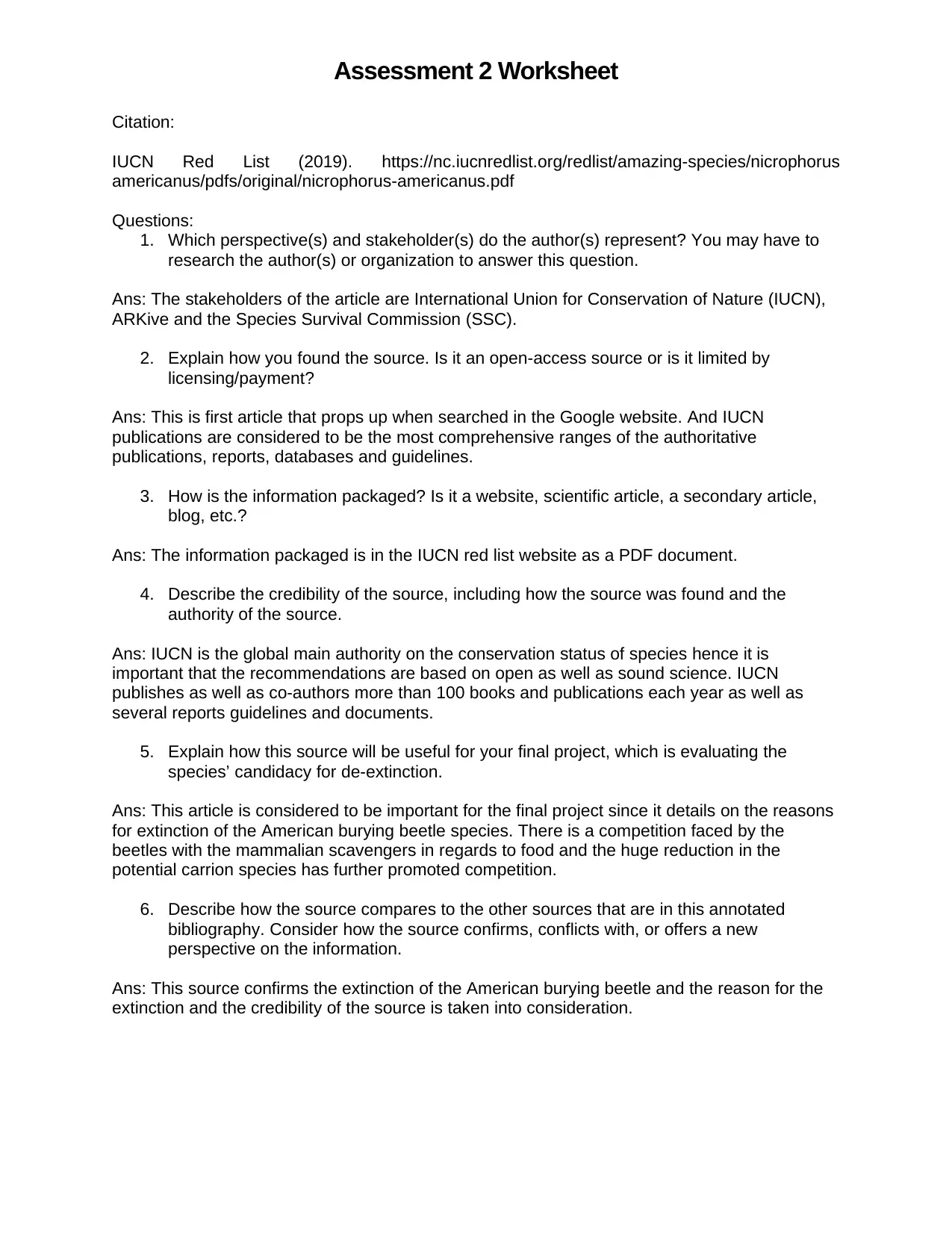
Assessment 2 Worksheet
Citation:
IUCN Red List (2019). https://nc.iucnredlist.org/redlist/amazing-species/nicrophorus
americanus/pdfs/original/nicrophorus-americanus.pdf
Questions:
1. Which perspective(s) and stakeholder(s) do the author(s) represent? You may have to
research the author(s) or organization to answer this question.
Ans: The stakeholders of the article are International Union for Conservation of Nature (IUCN),
ARKive and the Species Survival Commission (SSC).
2. Explain how you found the source. Is it an open-access source or is it limited by
licensing/payment?
Ans: This is first article that props up when searched in the Google website. And IUCN
publications are considered to be the most comprehensive ranges of the authoritative
publications, reports, databases and guidelines.
3. How is the information packaged? Is it a website, scientific article, a secondary article,
blog, etc.?
Ans: The information packaged is in the IUCN red list website as a PDF document.
4. Describe the credibility of the source, including how the source was found and the
authority of the source.
Ans: IUCN is the global main authority on the conservation status of species hence it is
important that the recommendations are based on open as well as sound science. IUCN
publishes as well as co-authors more than 100 books and publications each year as well as
several reports guidelines and documents.
5. Explain how this source will be useful for your final project, which is evaluating the
species’ candidacy for de-extinction.
Ans: This article is considered to be important for the final project since it details on the reasons
for extinction of the American burying beetle species. There is a competition faced by the
beetles with the mammalian scavengers in regards to food and the huge reduction in the
potential carrion species has further promoted competition.
6. Describe how the source compares to the other sources that are in this annotated
bibliography. Consider how the source confirms, conflicts with, or offers a new
perspective on the information.
Ans: This source confirms the extinction of the American burying beetle and the reason for the
extinction and the credibility of the source is taken into consideration.
Citation:
IUCN Red List (2019). https://nc.iucnredlist.org/redlist/amazing-species/nicrophorus
americanus/pdfs/original/nicrophorus-americanus.pdf
Questions:
1. Which perspective(s) and stakeholder(s) do the author(s) represent? You may have to
research the author(s) or organization to answer this question.
Ans: The stakeholders of the article are International Union for Conservation of Nature (IUCN),
ARKive and the Species Survival Commission (SSC).
2. Explain how you found the source. Is it an open-access source or is it limited by
licensing/payment?
Ans: This is first article that props up when searched in the Google website. And IUCN
publications are considered to be the most comprehensive ranges of the authoritative
publications, reports, databases and guidelines.
3. How is the information packaged? Is it a website, scientific article, a secondary article,
blog, etc.?
Ans: The information packaged is in the IUCN red list website as a PDF document.
4. Describe the credibility of the source, including how the source was found and the
authority of the source.
Ans: IUCN is the global main authority on the conservation status of species hence it is
important that the recommendations are based on open as well as sound science. IUCN
publishes as well as co-authors more than 100 books and publications each year as well as
several reports guidelines and documents.
5. Explain how this source will be useful for your final project, which is evaluating the
species’ candidacy for de-extinction.
Ans: This article is considered to be important for the final project since it details on the reasons
for extinction of the American burying beetle species. There is a competition faced by the
beetles with the mammalian scavengers in regards to food and the huge reduction in the
potential carrion species has further promoted competition.
6. Describe how the source compares to the other sources that are in this annotated
bibliography. Consider how the source confirms, conflicts with, or offers a new
perspective on the information.
Ans: This source confirms the extinction of the American burying beetle and the reason for the
extinction and the credibility of the source is taken into consideration.
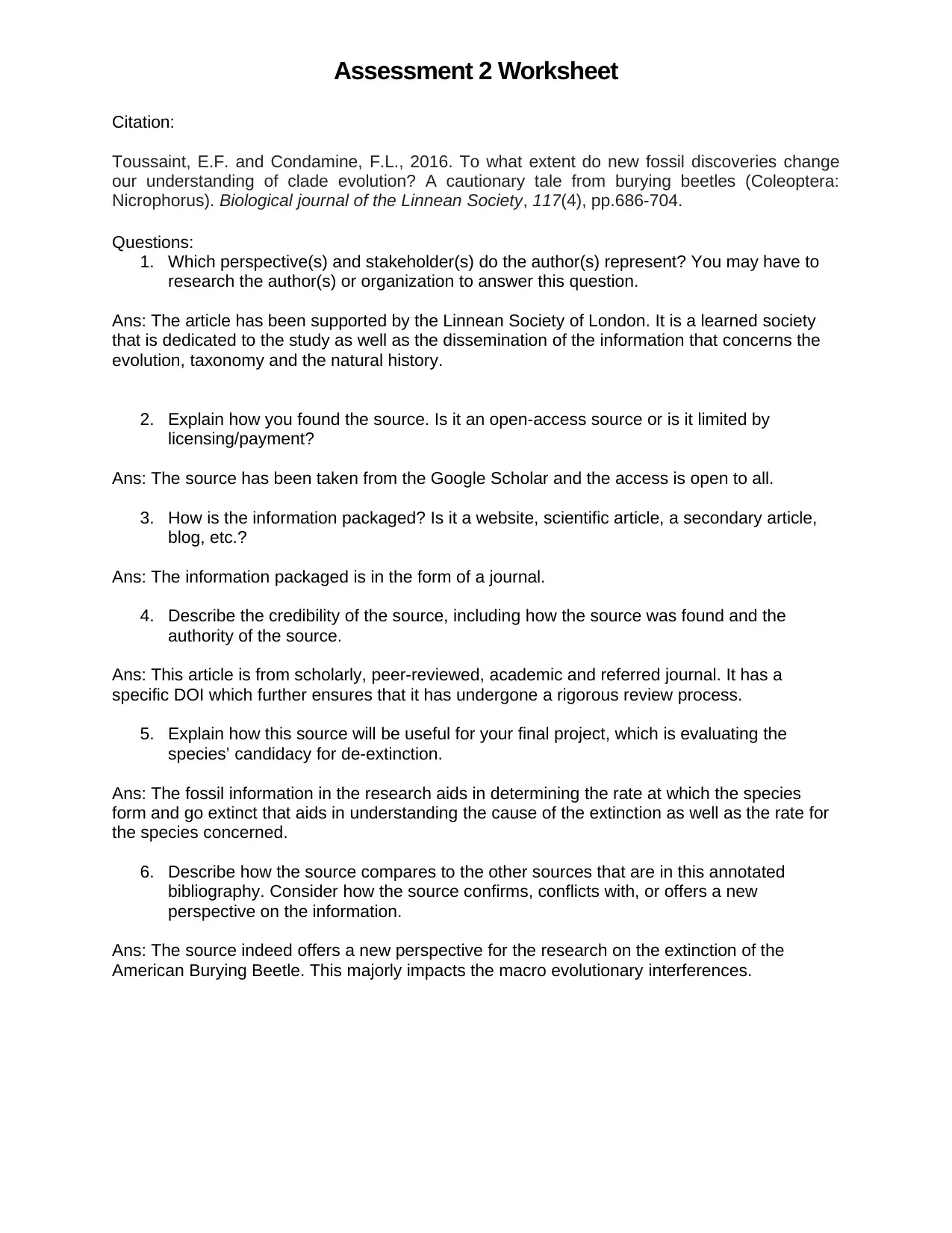
Assessment 2 Worksheet
Citation:
Toussaint, E.F. and Condamine, F.L., 2016. To what extent do new fossil discoveries change
our understanding of clade evolution? A cautionary tale from burying beetles (Coleoptera:
Nicrophorus). Biological journal of the Linnean Society, 117(4), pp.686-704.
Questions:
1. Which perspective(s) and stakeholder(s) do the author(s) represent? You may have to
research the author(s) or organization to answer this question.
Ans: The article has been supported by the Linnean Society of London. It is a learned society
that is dedicated to the study as well as the dissemination of the information that concerns the
evolution, taxonomy and the natural history.
2. Explain how you found the source. Is it an open-access source or is it limited by
licensing/payment?
Ans: The source has been taken from the Google Scholar and the access is open to all.
3. How is the information packaged? Is it a website, scientific article, a secondary article,
blog, etc.?
Ans: The information packaged is in the form of a journal.
4. Describe the credibility of the source, including how the source was found and the
authority of the source.
Ans: This article is from scholarly, peer-reviewed, academic and referred journal. It has a
specific DOI which further ensures that it has undergone a rigorous review process.
5. Explain how this source will be useful for your final project, which is evaluating the
species’ candidacy for de-extinction.
Ans: The fossil information in the research aids in determining the rate at which the species
form and go extinct that aids in understanding the cause of the extinction as well as the rate for
the species concerned.
6. Describe how the source compares to the other sources that are in this annotated
bibliography. Consider how the source confirms, conflicts with, or offers a new
perspective on the information.
Ans: The source indeed offers a new perspective for the research on the extinction of the
American Burying Beetle. This majorly impacts the macro evolutionary interferences.
Citation:
Toussaint, E.F. and Condamine, F.L., 2016. To what extent do new fossil discoveries change
our understanding of clade evolution? A cautionary tale from burying beetles (Coleoptera:
Nicrophorus). Biological journal of the Linnean Society, 117(4), pp.686-704.
Questions:
1. Which perspective(s) and stakeholder(s) do the author(s) represent? You may have to
research the author(s) or organization to answer this question.
Ans: The article has been supported by the Linnean Society of London. It is a learned society
that is dedicated to the study as well as the dissemination of the information that concerns the
evolution, taxonomy and the natural history.
2. Explain how you found the source. Is it an open-access source or is it limited by
licensing/payment?
Ans: The source has been taken from the Google Scholar and the access is open to all.
3. How is the information packaged? Is it a website, scientific article, a secondary article,
blog, etc.?
Ans: The information packaged is in the form of a journal.
4. Describe the credibility of the source, including how the source was found and the
authority of the source.
Ans: This article is from scholarly, peer-reviewed, academic and referred journal. It has a
specific DOI which further ensures that it has undergone a rigorous review process.
5. Explain how this source will be useful for your final project, which is evaluating the
species’ candidacy for de-extinction.
Ans: The fossil information in the research aids in determining the rate at which the species
form and go extinct that aids in understanding the cause of the extinction as well as the rate for
the species concerned.
6. Describe how the source compares to the other sources that are in this annotated
bibliography. Consider how the source confirms, conflicts with, or offers a new
perspective on the information.
Ans: The source indeed offers a new perspective for the research on the extinction of the
American Burying Beetle. This majorly impacts the macro evolutionary interferences.
Secure Best Marks with AI Grader
Need help grading? Try our AI Grader for instant feedback on your assignments.
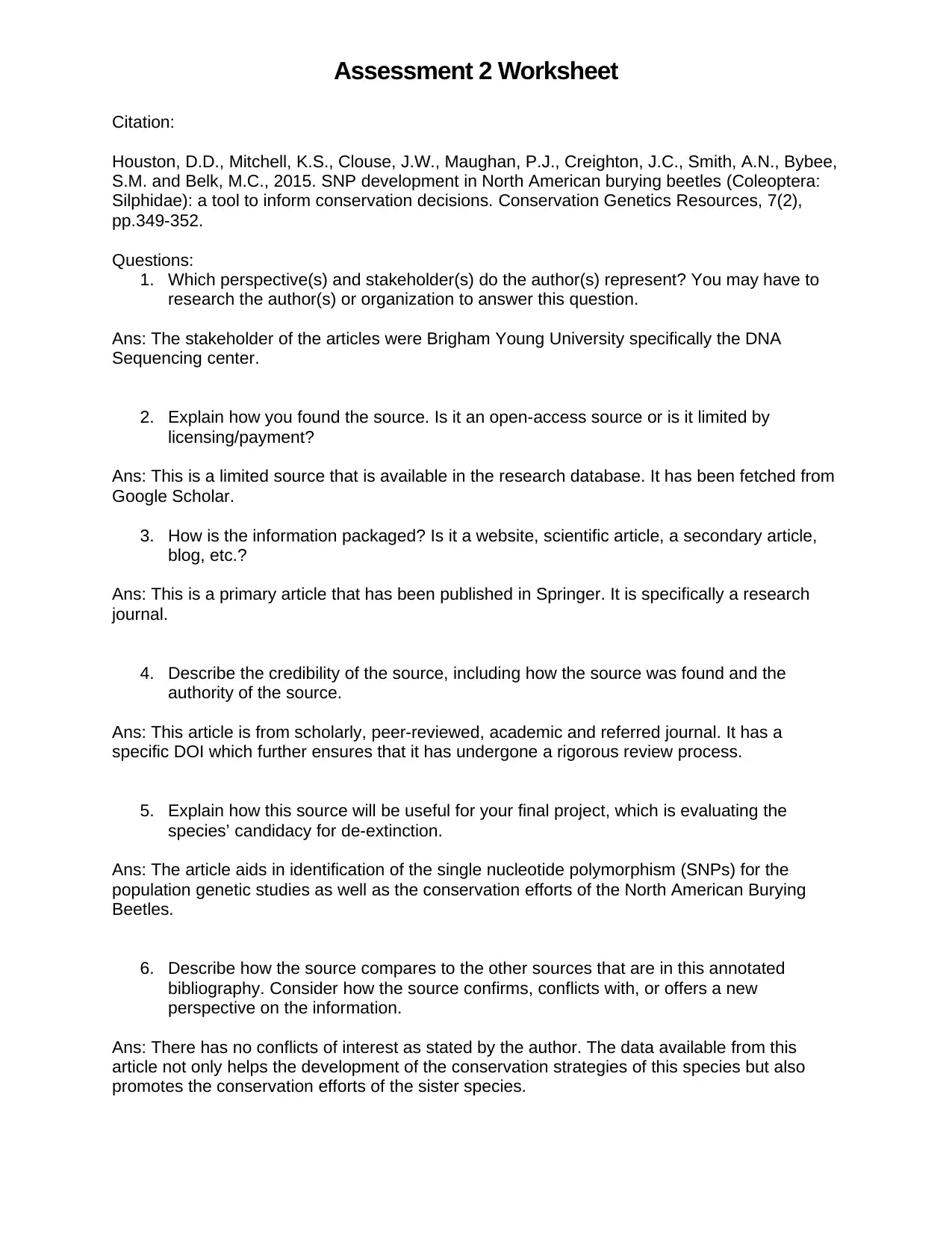
Assessment 2 Worksheet
Citation:
Houston, D.D., Mitchell, K.S., Clouse, J.W., Maughan, P.J., Creighton, J.C., Smith, A.N., Bybee,
S.M. and Belk, M.C., 2015. SNP development in North American burying beetles (Coleoptera:
Silphidae): a tool to inform conservation decisions. Conservation Genetics Resources, 7(2),
pp.349-352.
Questions:
1. Which perspective(s) and stakeholder(s) do the author(s) represent? You may have to
research the author(s) or organization to answer this question.
Ans: The stakeholder of the articles were Brigham Young University specifically the DNA
Sequencing center.
2. Explain how you found the source. Is it an open-access source or is it limited by
licensing/payment?
Ans: This is a limited source that is available in the research database. It has been fetched from
Google Scholar.
3. How is the information packaged? Is it a website, scientific article, a secondary article,
blog, etc.?
Ans: This is a primary article that has been published in Springer. It is specifically a research
journal.
4. Describe the credibility of the source, including how the source was found and the
authority of the source.
Ans: This article is from scholarly, peer-reviewed, academic and referred journal. It has a
specific DOI which further ensures that it has undergone a rigorous review process.
5. Explain how this source will be useful for your final project, which is evaluating the
species’ candidacy for de-extinction.
Ans: The article aids in identification of the single nucleotide polymorphism (SNPs) for the
population genetic studies as well as the conservation efforts of the North American Burying
Beetles.
6. Describe how the source compares to the other sources that are in this annotated
bibliography. Consider how the source confirms, conflicts with, or offers a new
perspective on the information.
Ans: There has no conflicts of interest as stated by the author. The data available from this
article not only helps the development of the conservation strategies of this species but also
promotes the conservation efforts of the sister species.
Citation:
Houston, D.D., Mitchell, K.S., Clouse, J.W., Maughan, P.J., Creighton, J.C., Smith, A.N., Bybee,
S.M. and Belk, M.C., 2015. SNP development in North American burying beetles (Coleoptera:
Silphidae): a tool to inform conservation decisions. Conservation Genetics Resources, 7(2),
pp.349-352.
Questions:
1. Which perspective(s) and stakeholder(s) do the author(s) represent? You may have to
research the author(s) or organization to answer this question.
Ans: The stakeholder of the articles were Brigham Young University specifically the DNA
Sequencing center.
2. Explain how you found the source. Is it an open-access source or is it limited by
licensing/payment?
Ans: This is a limited source that is available in the research database. It has been fetched from
Google Scholar.
3. How is the information packaged? Is it a website, scientific article, a secondary article,
blog, etc.?
Ans: This is a primary article that has been published in Springer. It is specifically a research
journal.
4. Describe the credibility of the source, including how the source was found and the
authority of the source.
Ans: This article is from scholarly, peer-reviewed, academic and referred journal. It has a
specific DOI which further ensures that it has undergone a rigorous review process.
5. Explain how this source will be useful for your final project, which is evaluating the
species’ candidacy for de-extinction.
Ans: The article aids in identification of the single nucleotide polymorphism (SNPs) for the
population genetic studies as well as the conservation efforts of the North American Burying
Beetles.
6. Describe how the source compares to the other sources that are in this annotated
bibliography. Consider how the source confirms, conflicts with, or offers a new
perspective on the information.
Ans: There has no conflicts of interest as stated by the author. The data available from this
article not only helps the development of the conservation strategies of this species but also
promotes the conservation efforts of the sister species.
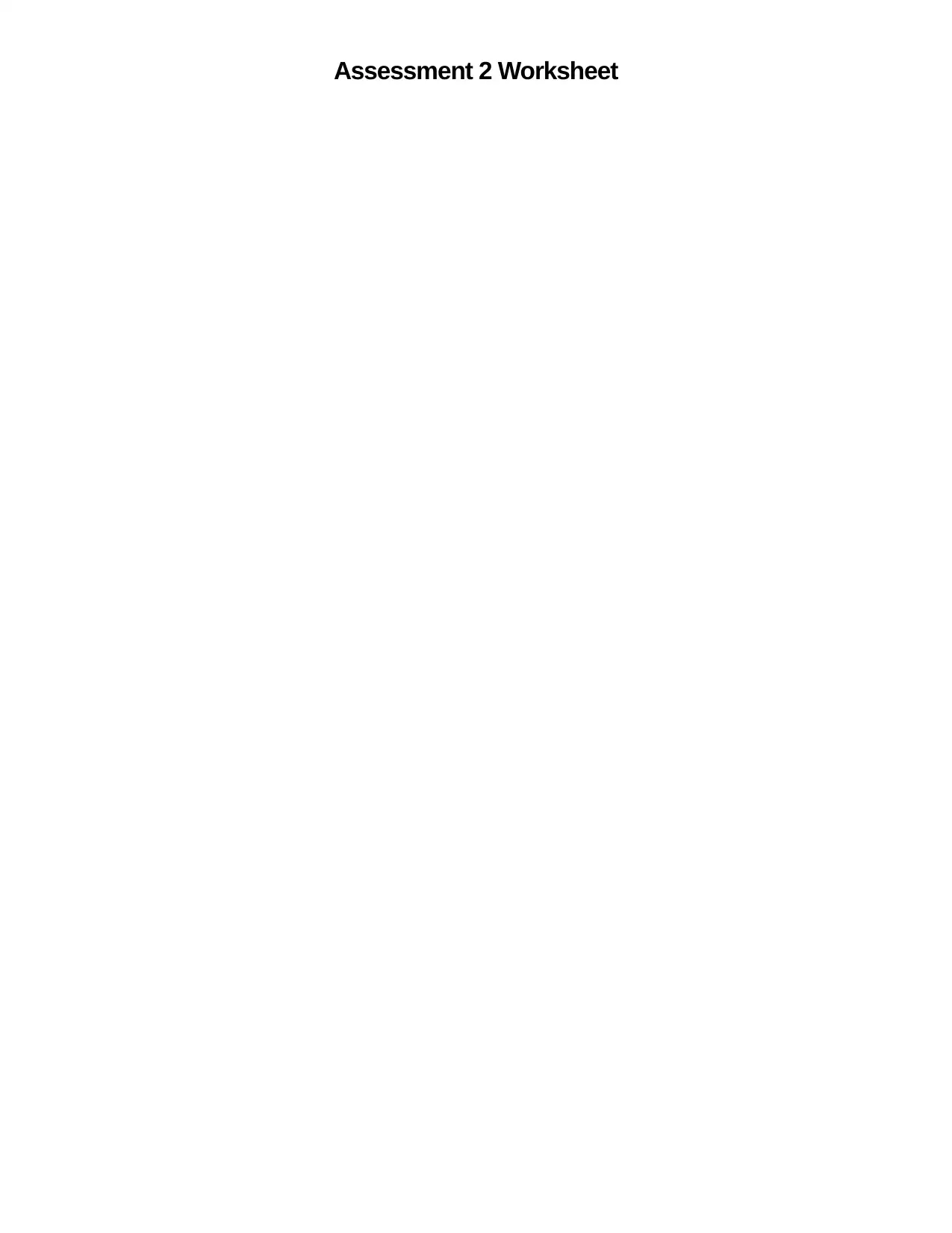
Assessment 2 Worksheet
1 out of 6
Your All-in-One AI-Powered Toolkit for Academic Success.
+13062052269
info@desklib.com
Available 24*7 on WhatsApp / Email
![[object Object]](/_next/static/media/star-bottom.7253800d.svg)
Unlock your academic potential
© 2024 | Zucol Services PVT LTD | All rights reserved.